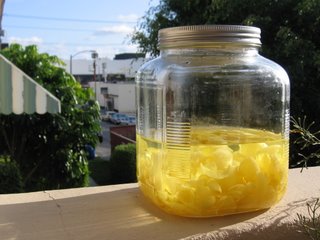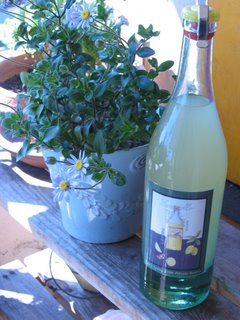
Last autumn, I spent five weeks traveling the length of Vietnam, cooking and eating as part of my research for Communion: Meditations on Eating in Vietnam, to be published in Spring 2007 by Things Asian Press. It was an incredible trip, and particularly meaningful for me, since I lived in Vietnam from 1995 to 1999. Communion is part travel essay, part cookbook, part history, sociology and philosophy book, exploring the culture of Vietnam through its culinary traditions. It examines how a country eats during times of famine and feast, and how we eat reflects who we are as individuals and communities.
In regard to recipes, I am taking the MFK Fisher approach, which she described in the introduction to Serve It Forth: “Recipes in my book will be there like birds in a tree—if there is comfortable branch.” Because there are many excellent Vietnamese cookbooks available, I think it’s silly to include a ton of recipes in mine. Those who want a comprehensive recipe repertoire should look to the works of Mai Pham, or at my friend Ann Le’s The Little Saigon Cookbook. Instead, I’m including a handful of recipes that captured the unique characters of the regions I visited. One that reflects the southern coastal region is Ca Kho (Clay Pot Fish). This is an incredibly simple dish of fish simmered in a light caramel sauce, and it is ridiculously good, with its extremes of sweet and spicy. So far, I’ve made it three times here at home, and I am continuing my experiments with different kinds of fish. I would love to have others try this recipe and give me their feedback. Since I'm also new to recipe writing, suggestions on this aspect are also appreciated.

CA KHO/CLAY POT FISH – 1 serving
PREPARE FISH:
- ½ lb. halibut cut into 1-inch chunks. (Cod is too oily and breaks apart while simmering. Grouper is used in Vietnam. My friend Ann Le recommends catfish. I have also tried this with chicken, which is terrific. And my friend Janet used shrimp, which she said is her favorite so far.)
- 1 Tbsp. fish sauce (see below for my note on fish sauce)
- up to 1 Tbsp. peanut oil
1. Marinate the cut fish in fish sauce, add a little oil.
2. Put fish in a clay pot. Pour the remainder of marinade over the top of the fish. (TIP: I first warm the clay pot with hot water, to keep it from cracking when it heats up on the stove.)
PREPARE SAUCE:
- 2 Tbsp. peanut oil
- 4 Tbsp. organic sugar
- 2 Tbsp. shallots, minced
- 1 clove garlic, minced
- 2 1-inch chunks ginger, peeled
- ½ cup coconut juice, not milk! (I use water, because I don’t have a sweet tooth)
- 2 whole red Thai chilies
- 1 Tbsp. fish sauce
- pinch black pepper
1. Heat oil in a heavy bottom pan. Add sugar and reduce until sugar dissolves. The mixture may seem too dry at first, or the sugar may crystallize a bit. Be patient and keep stirring. Make sure the heat is high enough. Eventually, the sugar will dissolve.
2. Add minced shallots, garlic and ginger.
3. Add coconut juice or water. Make sure it’s hot before you add it. If not, the cold liquid hitting the hot oil/sugar will cause an instant case of hard candy. If this happens, just keep stirring until the “candy” dissolves.
4. Add chilies.
5. Add fish sauce.
6. Add a pinch of black pepper.
7. Bring the sauce to a boil and then down to a simmer.
8. Put clay pot with fish on a burner and heat. Don’t brown the fish, but simply warm it up a bit. Now that I’ve used my clay pot a few times, it produces the most mouth-watering smell when I heat it up.
9. Add caramel sauce to clay pot.
10. Simmer, covered, for 20 minutes.
You can multiply this recipe and make it in a large clay pot for groups. When expanding the recipe, cut back on the oil in both parts of the recipe. If you do a true multiplication of the oil, the dish will be too ... you got it: oily. For accompaniment, I suggest something neutral, since the sauce is very flavorful. Try a green veggie such as Chinese broccoli stir-fried in garlic, peanut oil and maybe even a little oyster sauce. Serve plenty of rice for sopping up the sauce. (Trader Joe's brown California rice is the best.) I actually drank the remaining sauce the last time I tried this.
Remove chilis before serving. Or WARN guests that they are there. I speak from experience! Also let them know that there are big chunks of ginger, which are not meant to be eaten.
Note on Fish Sauce:
This is a controversial subject, since Vietnamese fish sauce, which is considered the best by many (thus the controversy), is not available in the U.S. Most fish sauces you can buy are from Thailand, and all that I’ve found so far during my research have sugar added to them. A true fish sauce is made only with whole anchovies and salt. You may need to experiment with a few brands before you find one that works for you: fish sauce is essential to the balance of hot, sour, salty and sweet in your dish. I’m fairly happy with the King Crab brand I get at the Bangkok Supermarket on Melrose Avenue in L.A.
Note on Chilies:
Not being a chef, I didn't know the dangers of chilies until recently, when preparing this dish for a party of 25 in Paso Robles. I prepped the ingredients the night before the party in my apartment in L.A. I minced approximately 40 red Thai chilies, bare-handed. I spent the rest of the evening, nearly 6 hours, with my hands soaking in a bowl of iced buttermilk. I took them out only to drink more red wine, which was working in conjunction with the buttermilk to ease what is possibly the most excruciating pain I have ever experienced, and to switch to the next Sex and the City episode on my DVD player. I finally fell asleep at 1 a.m., after taking a Xanax, with my hands wrapped around frozen packages of edamame. When mincing chilies, USE GLOVES!
P.S. The top pic was taken by my sis. She took all the photos for the book.







